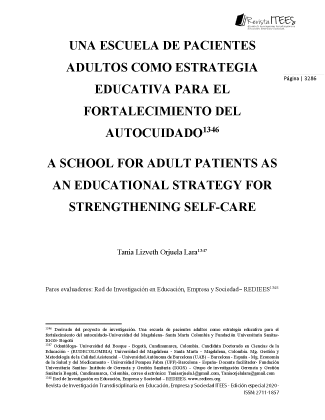CLXXII. A SCHOOL FOR ADULT PATIENTS AS AN EDUCATIONAL STRATEGY FOR STRENGTHENING SELF-CARE
##plugins.themes.bootstrap3.article.main##
Abstract
This work recounts the concepts that currently frame patient schools, with the aim of
identifying the scope of these schools, their usefulness and understanding how the doctorpatient paradigm has been changing. It arises from a documentary review, which found that
the patient school is a concept raised by Stanford University in the 70s for the management
of chronic diseases. Currently, there are different models in various parts of the world for the
self-care of patients with defined pathologies, expert patients, caregiver programs and others,
their focus being the empowerment of patients with chronic diseases. In conclusion, teaching
patients is preventing them from having unexpected health events or falling into
unmanageable situations; Hence, this document recognizes its importance; so that they are
more participatory and develop their own skills where education and self-knowledge is part
of their actions towards their health as proposed by the WHO since 1986 with the Ottawa
Charter
Download Statistics
##plugins.themes.bootstrap3.article.details##
patient school, patient education, learning space, health empowerment, self-care
https://www.youtube.com/watch?v=XQ3VgQZyj6o
Arthritis Ireland. (2013, 11, 06) The Case for Self-Management: Prof. Kate Lorig, Stanford
University. [Archivo de video]. Recuperado de
https://www.youtube.com/watch?v=v3Sz8kyHVwY
Bunge, E. (2008). Entrevista con Albert Bandura. Revista Argentina de Clínica Psicológica,
17(2), 183-188. Recuperado el 18 de octubre de 2019 de
https://www.redalyc.org/pdf/2819/281921780014.pdf.
Centro de recursos de autogestión. (2019). California, EE. UU.:
https://www.selfmanagementresource.com/about/history/. consultado 8 de octubre
2019.
Escuela de Pacientes. Escuela de pacientes: "de igual a igual"(4/12/2014). [Archivo de
video]. Recuperado de https://www.youtube.com/watch?v=JaRnYWcAxIc
Escuela de Pacientes. Kate Lorig en la Escuela de Pacientes.mov. (1/02/2012). [Archivo de
video]. Recuperado de https://www.youtube.com/watch?v=NYLNyjilh3U
Hevia Fernández, J. R., & Cofiño Fernández, R. Proyecto Escuela de Pacientes (2015)
recuperado 10 septiembre de 2019.
https://ria.asturias.es/RIA/bitstream/123456789/9467/1/Archivo.pdf
Lorig, K., & Holman, R. (2003). Self-management education: History, definition, outcomes,
and mechanisms. Annals of Behavioral Medicine, 26(1), 1-7.
Ministerio de la Protección Social & Universidad CES; (2015). Guía técnica "buenas
prácticas para la seguridad del paciente en la atención en salud". Seguridad del
Paciente; Calidad de la atención en salud; Seguridad del Paciente. Recuperado el
18/06/2019 de:
https://www.minsalud.gov.co/sites/rid/Lists/BibliotecaDigital/RIDE/DE/CA/Guiabuenas-practicas-seguridad-paciente.pdf
Ministerio de la Protección Social; (2008). Colombia. Instituto Nacional de Cancerología &
Colombia. Guía para la comunicación educativa en el marco del control del cáncer.
50 p. Recuperado de:
https://www.minsalud.gov.co/sites/rid/Lists/BibliotecaDigital/RIDE/IA/INCA/guiacomunicacion-educativa-control-cancer.pdf consultado 8 de octubre 2019
MINSALUD (2019). Política de participación social en salud PPSS. Resolución 2063 de
2017. Participación ciudadana en salud; 47 p. Recuperado de:
https://www.minsalud.gov.co/sites/rid/Lists/BibliotecaDigital/RIDE/DE/GT/politica
-ppss-resolucion-2063-de-2017-cartilla.pdf
Nuño-Solinis, R., Rodríguez-Pereira, C., Piñera-Elorriaga, K., Zaballa-González, I., &
Bikandi-Irazabal, J. (2013). Panorama de las iniciativas de educación para el
autocuidado en España. Gaceta Sanitaria, 27(4), 332-337. Recuperado el 10/09/2019
de: http://dx.doi.org/10.1016/j.gaceta.2013.01.008





